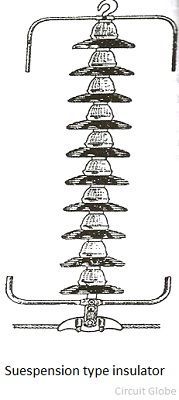Overhead line insulators are used to separate line conductors from each other and the supporting structures electrically. Permittivity and dielectric strength of the insulating material are very high so that it can withstand high electrical stress. Insulators protect the transmission line from overvoltages which occur due to lightning, switching, or other causes under the severe condition. There are three main types of insulation used for the overhead line.
- Pin type insulator
- Suspension type insulator
- Strain or tension-type insulator
Pin type insulator
It is used for the transmission of lower voltages up to 33kv. The pin insulator is supported on a bolt which is secured to the cross arm of the supporting structures. The conductor is tied to the insulator on the top groove. Single piece type insulator is used for lower voltage, but for higher voltages, two or more pieces are connected to provide sufficient thickness of porcelain. A pin type insulator is shown in the figure below
 Suspension types insulator
Suspension types insulator
A suspension type insulator consists of some separate insulator units connected to each other by metal links to form a flexible chain or a string. The insulator string is hanged from the cross arm of the support. The conductor is attached to the lower unit of the insulator.
 Strain or tension-type insulator
Strain or tension-type insulator
Strain or tension is designed for handling mechanical stress at angle positions where there is a change in the direction of the line or at the terminations of the lines. For high voltage lines having longer spans and greater mechanical loading, suspension insulator strings are arranged in a horizontal position.

plz give some refrences of the two insulators pictures
Is pin insulator spindle, the same as disc insulator